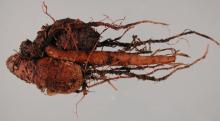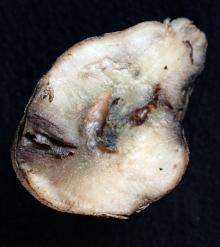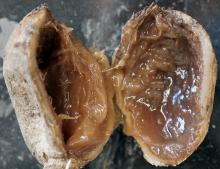See:
Calla Lily (Zantedeschia spp.) - Soft Rot
Iris, Rhizomatous (Iris spp.) - Bacterial Soft Rot
Cause The bacterium Pectobacterium carotovorum attacks several hosts including calla lily, iris, and dahlia. The organism is in most cultivated soils and regularly overwinters in soil. Bacterial soft rot can attack plants any time of the year but often is noticed in the critical months before bloom. The organism enters through wounds. The disease has also been associated with contaminated surface waters used for overhead irrigation.
Symptoms Tubers become discolored, soft and mushy. The entire tuber may hollow out and decay in advanced cases.
Cultural control
- Destroy all infected plants and tubers.
- Let dahlia roots continue to grow and mature as long as practical even after light frosts.
- Avoid wounding tubers when digging. Dig in dry weather if possible.
- Store tubers at a constant, cool temperature in a range of 40 to 45 degrees and keep from freezing temperatures.
- Dry tubers and replant in a new well-drained site.
- Use well water or disinfected surface water for irrigation.
Chemical control Combine with cultural control methods because chemical control is difficult and often ineffective.
- Agri-Mycin 50 at 2.7 to 5.3 oz/100 gal water. Tolerant strains of bacteria easily develop with repeated use of this product. Alternate with other bactericides to prevent or delay buildup of tolerant strains. Group 25 fungicide. 12-hr reentry.
- KleenGrow at 0.15 to 1.5 fl oz/gal water. Soak for 30 seconds and allow to drain.
- Phyton 27 at 1.5 to 2 oz/10 gal water. Group M1 fungicide. 48-hr reentry.
Reference Lacy, G.H., Lambe, R.C., and Berg, C.M. 1982. Iris soft rot caused by Erwinia chrysanthemi, associated with overhead irrigation and its control by chlorination. In Combined Proceedings International Plant Propagators' Society 31:624-634.




